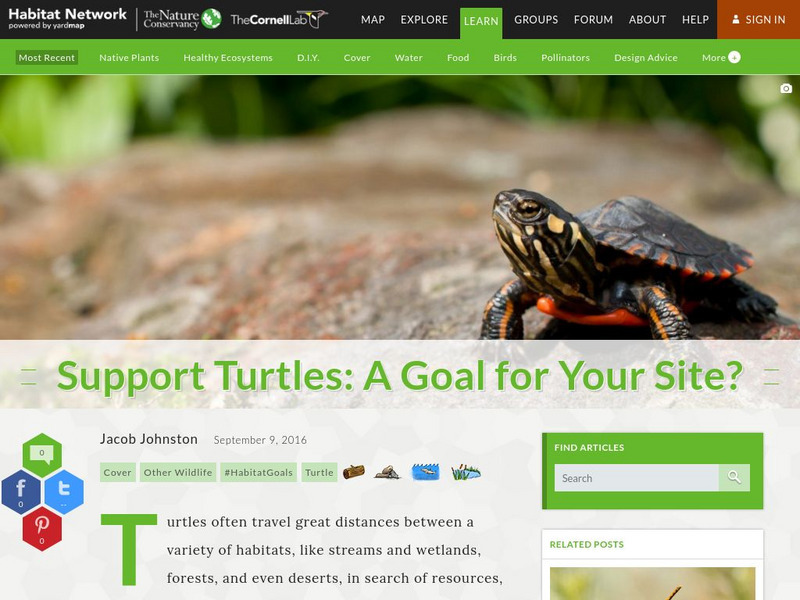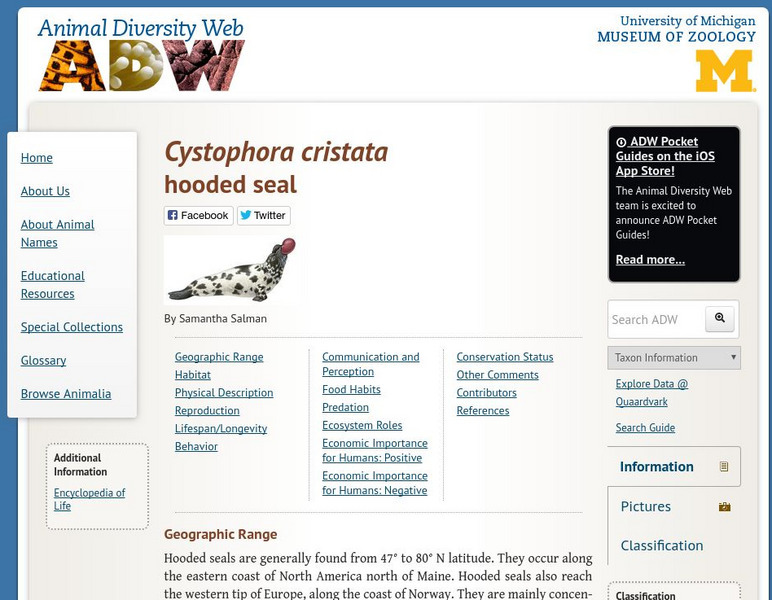Animal Fact Guide
Animal Fact Guide: Bonobo
Where in the world can you see a bonobo in the wild? This reference site features information not only on the habitat of the bonobo but also its physical characteristics, diet, breeding patterns, unique traits and behavior, conservation...
Royal Canadian Geographical Society
Canadian Geographic: Animal Facts: Wolverine
A profile of the wolverine including physiology, habitat, behaviors, range, and basic facts.
Royal Canadian Geographical Society
Canadian Geographic: Animal Facts: Steller Sea Lion
A profile of the Steller sea lion including physiology, habitat, behaviors, range, and basic facts.
Royal Canadian Geographical Society
Canadian Geographic: Animal Facts: Beluga Whale
Learn facts, physiology, habitat, behaviors and range of the beluga whale. A fact sheet is also available for download.
Royal Canadian Geographical Society
Canadian Geographic: Animal Facts: Arctic Fox
Offers quick facts on the Arctic fox about physical appearance, habitat, behavior and its range.
Royal Canadian Geographical Society
Canadian Geographic: Animal Facts: Caribou
Offers quick facts on the caribou about physical appearance, habitat, behavior and range.
Royal Canadian Geographical Society
Canadian Geographic: Animal Facts: Greenland Shark
Offers quick facts on the Greenland shark about physical appearance, habitat, behavior and its range.
Royal Canadian Geographical Society
Canadian Geographic: Animal Facts: Grizzly Bear
Offers quick facts on the grizzly bear about physical appearance, habitat, behavior and its range.
Royal Canadian Geographical Society
Canadian Geographic: Animal Facts: Moose
Offers quick facts on the moose about physical appearance, habitat, behavior and its range.
Royal Canadian Geographical Society
Canadian Geographic: Animal Facts: Polar Bear
Offers quick facts on the polar bear about physical appearance, habitat, behavior and its range.
Royal Canadian Geographical Society
Canadian Geographic: Animal Facts: Wolf
Offers quick facts on the wolf about physical appearance, habitat, behavior and its range.
ClassFlow
Class Flow: Animal Adaptation
[Free Registration/Login Required] Students will investigate the habitats of different organisms and the dependence of organisms on their habitat and recognize that organisms have specific traits that help them adapt so they can carry...
E-learning for Kids
E Learning for Kids: Science: Mexico: What Is a Habitat?
Sofia came back from a trip around the world. She noticed how each animal she saw belonged to a certain habitat. Help her learn about animal habitats and the species that live there.
Regents of the University of Michigan
Animal Diversity Web: Geochelone Radiata (Radiated Tortoise)
Site contains information on the Geochelone radiata (Radiated Tortoise). Includes geographic range, habitat, physical description, reproduction, food habits, and conservation status.
Regents of the University of Michigan
Animal Diversity Web: Pongo Pygmaeus (Orangutan)
Site contains information on the Pongo Pygmaeus (Orangutan). Includes geographic range, habitat, physical description, reproduction, behavior, food habits, and conservation status as well as other information and pictures.
Regents of the University of Michigan
Animal Diversity Web: Salamandra Salamandra (Fire Salamander)
Site contains information on the Salamandra Salamandra (Fire Salamander). Includes geographic range, habitat, physical description, reproduction, behavior, food habits, and conservation status as well as other information and pictures.
Cornell Lab of Ornithology
Habitat Network: Habitat Feature: Making Mud
Find out how mud puddles in a backyard ecosystem make for a welcome habitat for many species.
Writing Fix
Writing Fix: A Habitat for a Wild "Pet"
After observing and naming elements of an animal's habitat, and reading The Salamander Room by Anne Mazer, students write fictional stories about finding and caring for a wild animal. A printable graphic organizer, a teacher example, and...
Cornell Lab of Ornithology
Habitat Network: Support Turtles: A Goal for Your Site?
Find out how a common backyard habitat can become a welcome habitat site for turtles.
Regents of the University of Michigan
Animal Diversity Web: Hooded Seal
A complete site that provides information on geographic range, habitat, physical description, reproduction, behavior, diet, economic importance, and the conservation status of the Hooded Seal.
Regents of the University of Michigan
Animal Diversity Web: Weddell Seal
This effective site provides information on geographic range, habitat, reproduction, behavior, diet, and economic importance.
Regents of the University of Michigan
Animal Diversity Web: Ross Seal
A complete site that delves into geographic location, habitat, physical description, reproduction, diet, predation, economic importance (positive/negative), and conservation status.
Regents of the University of Michigan
Animal Diversity Web: Spotted Seal
A complete site that delves into geographic range, habitat, physical description, reproduction, lifespan, diet, predation, economic importance (positive/negative), and conservation status.
Regents of the University of Michigan
Animal Diversity Web: Harbor Seal
Geographic range, habitat, physical description, reproduction, behavior, food habits, economic importance (negative/positive), and conservation status are all part of this complete site.
Other popular searches
- Animal Habitats
- Powerpoint Animal Habitats
- Animal Habitats in Georgia
- Animal Habitats Math Games
- Animal Habitat Diorama
- Animal Habitats Kindergarten
- Plant and Animal Habitats
- Animal Winter Habitats
- Lessons on Animal Habitats
- Animal Habitats Adaptation
- Math Animal Habitats
- Animal Habitats and Zoos













